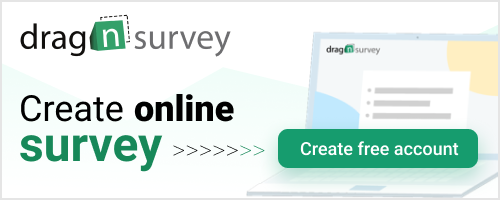Quantitative research is usually implemented to conduct measurements with an audience. The goal is to obtain quantifiable data regarding for example an audience, the perception of a message, satisfaction, etc.
This data collection method is used in order to determine market needs, but also to meet other specific needs such as: testing a concept, validating targeting, identifying expectations, understanding habits, obtaining feedback, etc.
Quantitative research most often uses a survey to collect data. To ensure its success, it is important to ensure the quality of the questions asked, to properly select the sample that the study will target, and to properly analyze the results obtained, without forgetting the method of collecting responses. It should be known that building a quantitative study can now be done using online survey tools to save even more time.
What are the steps to follow to conduct quantitative research and what are the questions to prioritize in order to obtain convincing results? Here is everything you need to know in this article.
>> To discover the differences between qualitative research and quantitative research, click here

Conduct quantitative research in 7 steps
For the quantitative study to be successful, it is important to proceed methodically. In practice, there are 7 essential steps to conduct quantitative research.
1. Define the issue
The first step is to define the problem and more precisely the main question that the study is supposed to answer. This is in a way the objective targeted by the latter.
Defining the objective allows the survey questions to be written. The answers obtained will make it possible to respond to the defined issue.
2. Choose the method for collecting data
Many data collection methods can be used in a survey, the most commonly used being the survey.
Using a survey makes it possible to collect information about one’s market. The data collected in this context somehow has an expiration date. The survey makes it possible to study a fact or answer a specific question.
3. Define the sample
Delimiting the sample consists in defining the audience that can respond optimally to the established questionnaire. It can be carried out on the basis of different criteria, in particular demographic: age, gender, place of residence, household composition, etc.
If useful, it may be relevant to segment the sample. Indeed, the questions to be asked may differ if the chosen population is the direct or indirect target of a product or service.
The quality of quantitative research depends greatly on the quality of the established sample, which is why this step is crucial when developing it.
4. Master the subject of quantitative study
The best way to collect useful information on a topic is obviously to learn about it. This also proves necessary to be credible with the people interviewed. Indeed, these people may eventually seek to obtain information on the subject before answering the questions asked.
5. Conduct quantitative research
Many solutions can be adopted to submit the survey to the sample. Currently, it is possible to distribute the questionnaire on social networks, forums, blog comments, by email or directly to a consumer panel. It is also possible to interview respondents face-to-face or by phone.
One of the advantages of an online survey is that respondents can complete it whenever they want.
6. Process and analyze the results
In order to exploit the data obtained as part of quantitative research, it is necessary to analyze it. With an online survey solution, the data is processed directly by the software.
It is possible to apply filters from the software to sort and segment the data. By doing so, it becomes easier to compare the information to each other, draw meaning from it and draw a relevant conclusion.
7. Share the research report
Conducting quantitative research should allow the implementation of a report. To demonstrate the relevance of the study, this report must highlight the answers to the initial issue and above all, lead to the development of strategic decisions.
One of the advantages of an online survey solution is that reports are generated automatically.

Examples of quantitative questions
Quantitative research must be established in order to obtain quality and relevant results. Indeed, poorly worded, off-topic or overly vague questions can compromise these results, which is why it is important to use quantitative questions, which can take different forms.
Closed-ended single response questions
Closed-ended single response questions frame the responses that the respondent can give and make it possible to impose a particular type of response. They also guarantee obtaining very precise information.
This type of question thus suggests responses such as: yes or no. In some exceptional cases, it is possible to accept a response of the “other” type.
Closed-ended multiple response questions
This type of multiple choice question allows respondents to give several responses to a single question. It is necessary to specify in the wording of the question that it is possible to provide several answers.
The use of multiple choice questions makes it possible to obtain complete responses.
Closed-ended scale questions
Closed-ended scale questions are used to gauge and measure. The scales used are Likert scales, which offer evaluation items and the Osgood scale which offers a numerical evaluation.
Closed-ended scale questions are relevant for evaluating or gauging a feeling or impression (satisfaction with a product or service, understanding information, etc.).
Closed-ended ranking questions
Closed-ended ranking questions are used to gauge respondents’ preferences.
With an online survey software, the results are easy to process. It is therefore not necessary to limit the number of items to be ranked.
More about survey:
Cross-Cultural Digital Survey, click here
Client Recommendation Metric, click here
Typeform Replacement Options, click here
Form Building Alternatives to JotForm, click here
Different Platforms for Form Generation, click here
Form Creation Tools Besides Google Forms, click here
Top 10 Online Quiz Builders for Engaging Content, click here
The Importance of the Customer Satisfaction Score, click here
Benefits of Incorporating Multiple Choice Queries in Surveys, click here
10 Online Survey Platforms That Excel in Questionnaire Design, click here
Read the article:
French – étude quantitative, click here
German – quantitative Forschung, click here
Portuguese – pesquisa quantitativa, click here
